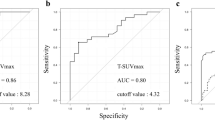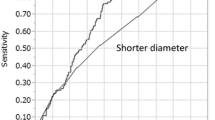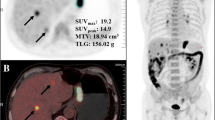Abstract
Background
The significance of 18F-2-deoxy-2-fluoro-glucose positron emission tomography combined with computed tomography imaging (FDG-PET/CT) in the diagnosis of gastric cancer remains controversial. This study aimed to evaluate the efficacy of preoperative FDG-PET/CT in staging of gastric cancer.
Methods
FDG-PET/CT results for 90 patients with gastric cancer were retrospectively examined. For quantitative PET analysis, FDG uptake was assessed based on the maximum standardized uptake values (SUVmax).
Results
FDG-PET/CT detected the primary gastric cancer in 71 of the 90 patients (sensitivity 78.9 %). The median SUVmax was significantly higher in patients with T3/T4 disease than in those with T1/T2 (9.0 vs. 3.8; P < 0.001), in patients with distant metastasis than in those with no metastasis (9.5 vs. 7.7; P = 0.018), and with stage III/IV tumors than in those with stage I/II (9.0 vs. 4.7; P = 0.017). The SUVmax of the primary tumor was significantly correlated with tumor size (r = 0.461, P < 0.001). The sensitivity, specificity, and accuracy of FDG-PET/CT in assessing metastasis to regional lymph nodes were 64.5, 85.7, and 71.1 %, respectively.
Conclusions
FDG-PET/CT results are significantly associated with tumor progression in gastric cancer, and such findings can reliably identify cancer cell populations.




Similar content being viewed by others
References
Jemal A, Siegel R, Ward E et al (2006) Cancer statistics, 2006. CA Cancer J Clin 56:106–130
Wu LM, Hu JN, Hua J et al (2012) 18F-fluorodeoxyglucose positron emission tomography to evaluate recurrent gastric cancer: a systematic review and meta-analysis. J Gastroenterol Hepatol 27:472–480
Kim KW, Choi BI, Han JK et al (2002) Postoperative anatomic and pathologic findings at CT following gastrectomy. Radiographics 22:323–336
Minamimoto R, Senda M, Terauchi T et al (2011) Analysis of various malignant neoplasms detected by FDG-PET cancer screening program: based on a Japanese Nationwide Survey. Ann Nucl Med 25:45–54
Shimada H, Okazumi S, Koyama M et al (2011) Japanese Gastric Cancer Association Task Force for Research Promotion: clinical utility of 18F-fluoro-2-deoxyglucose positron emission tomography in gastric cancer. A systematic review of the literature. Gastric Cancer 14:13–21
Dassen AE, Lips DJ, Hoekstra CJ et al (2009) FDG-PET has no definite role in preoperative imaging in gastric cancer. Eur J Surg Oncol 35:449–455
Chung HW, Lee EJ, Cho YH et al (2010) High FDG uptake in PET/CT predicts worse prognosis in patients with metastatic gastric adenocarcinoma. J Cancer Res Clin Oncol 136:1929–1935
Hur H, Kim SH, Kim W et al (2010) The efficacy of preoperative PET/CT for prediction of curability in surgery for locally advanced gastric carcinoma. World J Surg Oncol 8:86
Oh HH, Lee SE, Choi IS et al (2011) The peak-standardized uptake value (P-SUV) by preoperative positron emission tomography-computed tomography (PET-CT) is a useful indicator of lymph node metastasis in gastric cancer. J Surg Oncol 104:530–533
Sobin LH, Gospodarowicz MK, Wittekind C (eds) (2009) TNM classification of malignant tumours (7th Edition). Wiley-Blackwell, New York
Lauren P (1965) The two histological main types of gastric carcinoma: diffuse and so-called intestinal-type carcinoma. An attempt at a histoclinical classification. Acta Pathol Microbiol Scand 64:31–49
Yamamoto Y, Oguri H, Yamada R et al (2008) Preoperative evaluation of pelvic masses with combined 18F-fluorodeoxyglucose positron emission tomography and computed tomography. Int J Gynaecol Obstet 102:124–127
Taniguchi Y, Arii K, Kumon Y et al (2010) Positron emission tomography/computed tomography: a clinical tool for evaluation of enthesitis in patients with spondyloarthritides. Rheumatology 49:348–354
Inoue T, Oriuchi N, Kunio M et al (1999) Accuracy of standardized uptake value measured by simultaneous emission and transmission scanning in PET oncology. Nucl Med Commun 20:849–857
Japanese Gastric Cancer Association (1998) Japanese classification of gastric carcinoma: 2nd English edition. Gastric Cancer 1:10–24
Mochiki E, Kuwano H, Katoh H et al (2004) Evaluation of 18F-2-deoxy-2-fluoro-d-glucose positron emission tomography for gastric cancer. World J Surg 28:247–253
Mukai K, Ishida Y, Okajima K et al (2006) Usefulness of preoperative FDG-PET for detection of gastric cancer. Gastric Cancer 9:192–196
Herrmann K, Ott K, Buck AK et al (2007) Imaging gastric cancer with PET and the radiotracers 18F-FLT and 18F-FDG: a comparative analysis. J Nucl Med 48:1945–1950
Kameyama R, Yamamoto Y, Izuishi K et al (2009) Detection of gastric cancer using 18F-FLT PET: comparison with 18F-FDG PET. Eur J Nucl Med Mol Imaging 36:382–388
Kim SK, Kang KW, Lee JS et al (2006) Assessment of lymph node metastases using 18F-FDG PET in patients with advanced gastric cancer. Eur J Nucl Med Mol Imaging 33:148–155
Yun M, Lim JS, Noh SH et al (2005) Lymph node staging of gastric cancer using 18F-FDG PET: a comparison study with CT. J Nucl Med 46:1582–1588
Chen J, Cheong JH, Yun MJ et al (2005) Improvement in preoperative staging of gastric adenocarcinoma with positron emission tomography. Cancer 103:2383–2390
D’Elia F, Zingarelli A, Palli D et al (2000) Hydro-dynamic CT preoperative staging of gastric cancer: correlation with pathological findings. A prospective study of 107 cases. Eur Radiol 10:1877–1885
Rossi M, Broglia L, Maccioni F et al (1997) Hydro-CT in patients with gastric cancer: preoperative radiologic staging. Eur Radiol 7:659–664
Smyth E, Schöder H, Strong VE et al (2012) A prospective evaluation of the utility of 2-deoxy-2-[18F]fluoro-d-glucose positron emission tomography and computed tomography in staging locally advanced gastric cancer. Cancer 118:5481–5488
Kim EY, Lee WJ, Choi D et al (2011) The value of PET/CT for preoperative staging of advanced gastric cancer: comparison with contrast-enhanced CT. Eur J Radiol 79:183–188
Sano T, Sasako M, Kinoshita T et al (1993) Recurrence of early gastric cancer: follow-up of 1475 patients and review of the Japanese literature. Cancer 72:3174–3178
Okabayashi T, Kobayashi M, Nishimori I et al (2008) Clinicopathological features and medical management of early gastric cancer. Am J Surg 195:229–232
Namikawa T, Kitagawa H, Iwabu J et al (2010) Clinicopathological properties of the superficial spreading type early gastric cancer. J Gastrointest Surg 14:52–57
Stahl A, Ott K, Weber WA et al (2003) FDG PET imaging of locally advanced gastric carcinomas: correlation with endoscopic and histopathological findings. Eur J Nucl Med Mol Imaging 30:288–295
Yamada A, Oguchi K, Fukushima M et al (2006) Evaluation of 2-deoxy-2-[18F]fluoro-d-glucose positron emission tomography in gastric carcinoma: relation to histological subtypes, depth of tumor invasion, and glucose transporter-1 expression. Ann Nucl Med 20:597–604
Alakus H, Batur M, Schmidt M et al (2010) Variable 18F-fluorodeoxyglucose uptake in gastric cancer is associated with different levels of GLUT-1 expression. Nucl Med Commun 31:532–538
Kawamura T, Kusakabe T, Sugino T et al (2001) Expression of glucose transporter-1 in human gastric carcinoma: association with tumor aggressiveness, metastasis, and patient survival. Cancer 92:634–641
Israel O, Yefremov N, Bar-Shalom R et al (2005) PET/CT detection of unexpected gastrointestinal foci of 18F-FDG uptake: incidence, localization patterns, and clinical significance. J Nucl Med 46:758–762
Kostakoglu L, Hardoff R, Mirtcheva R et al (2004) PET-CT fusion imaging in differentiating physiologic from pathologic FDG uptake. Radiographic 24:1411–1431
Takahashi H, Ukawa K, Ohkawa N et al (2009) Significance of 18F-2-deoxy-2-fluoro-glucose accumulation in the stomach on positron emission tomography. Ann Nucl Med 23:391–397
Yasuda S, Takechi M, Ishizu K et al (2008) Preliminary study comparing diffuse gastric FDG uptake and gastritis. Tokai J Exp Clin Med 33:138–142
Lin CY, Liu CS, Ding HJ et al (2006) Positive correlation between standardized uptake values of FDG uptake in the stomach and the value of the C-13 urea breath test. Clin Nucl Med 31:792–794
Conflict of interest
No author has any conflict of interest.
Author information
Authors and Affiliations
Corresponding author
About this article
Cite this article
Namikawa, T., Okabayshi, T., Nogami, M. et al. Assessment of 18F-fluorodeoxyglucose positron emission tomography combined with computed tomography in the preoperative management of patients with gastric cancer. Int J Clin Oncol 19, 649–655 (2014). https://doi.org/10.1007/s10147-013-0598-6
Received:
Accepted:
Published:
Issue Date:
DOI: https://doi.org/10.1007/s10147-013-0598-6




